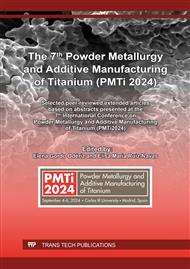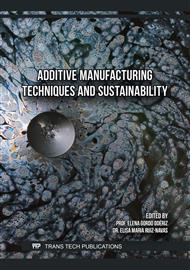[1]
N.S. Weston, B. Thomas, M. Jackson, Processing metal powders via field assisted sintering technology (FAST): a critical review, Mater. Sci. and Tech. 35 (2019) 1306–1328.
DOI: 10.1080/02670836.2019.1620538
Google Scholar
[2]
S. Lister, O. Levano Blanch, B. Fernández Silva, N.S. Weston and M. Jackson, A comparative study of microstructure and texture evolution in low-cost titanium alloy swarf and powder recycled via FAST and HIP, submitted to Mater. Sci. and Tech.
DOI: 10.1177/02670836241277060
Google Scholar
[3]
J. Pepper, O. Levano Blanch, B. Thomas and M. Jackson, Channelling electric current during the field-assisted sintering technique (FAST) to control microstructural evolution in Ti-6Al-4V. J. Mater Sci. Vol. 58, 14514-14532 (2023).
DOI: 10.1007/s10853-023-08884-8
Google Scholar
[4]
J.P. Campbell, R.O. Ritchie, Mixed-mode, high-cycle fatigue-crack growth thresholds in Ti–6Al–4V: I. A comparison of large and short-crack behaviour, Eng Fract Mech. 67 (2000) 209-227.
DOI: 10.1016/s0013-7944(00)00046-1
Google Scholar
[5]
N.S. Weston, D. Premoli, T. Childerhouse, O. Levano Blanch, M. Jackson, Assessing the mechanical properties of out-of-specification additive manufacturing Ti-6Al-4V powder recycled through field-assisted sintering technology (FAST). Powder Metall. 2024;67(1):70-85.
DOI: 10.1177/00325899231216673
Google Scholar
[6]
B. Fernández Silva, O. Levano Blanch, K. Sagoo, M. Jackson, Effect of processing route on ballistic performance of Ti-6Al-4V armour plate. Mater Sci and Tech. 39 (2023) 2910–2920.
DOI: 10.1080/02670836.2023.2229175
Google Scholar
[7]
N.S. Weston, M. Jackson, FAST-forge – a new cost-effective hybrid processing route for consolidating titanium powder into near-net shape forged components, J. Mater. Process. Technol. 243 (2017) 335-346.
DOI: 10.1016/j.jmatprotec.2016.12.013
Google Scholar
[8]
J.J. Pope, E.L. Calvert, N.S. Weston, M. Jackson, FAST-DB: A novel solid-state approach for diffusion bonding dissimilar titanium alloy powders for next generation critical components, J. Mater. Process. Technol. 269 (2019) 200-207.
DOI: 10.1016/j.jmatprotec.2019.02.011
Google Scholar
[9]
O. Levano Blanch, J. Pope, I. Violatos, S. Rahimi, M. Jackson, Residual Stress Distributions in Dissimilar Titanium Alloy Diffusion Bonds Produced From Powder Using Field-Assisted Sintering Technology (FAST-DB). Metall Mater Trans A 54 (2023) 3578–3593.
DOI: 10.1007/s11661-023-07115-8
Google Scholar
[10]
O. Levano Blanch, D. Lunt, G.J. Baxter, M. Jackson, Deformation Behaviour of a FAST Diffusion Bond Processed from Dissimilar Titanium Alloy Powders. Metall Mater Trans A 52 (2021) 3064–3082.
DOI: 10.1007/s11661-021-06301-w
Google Scholar



